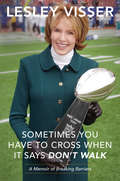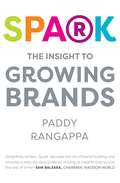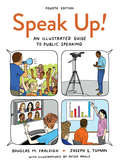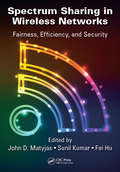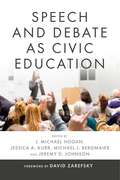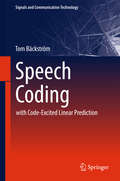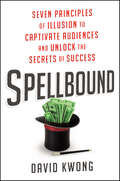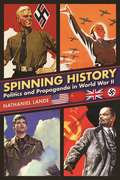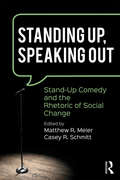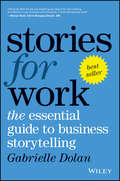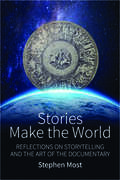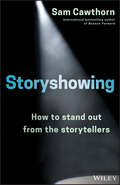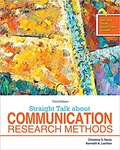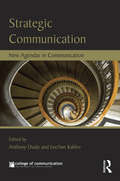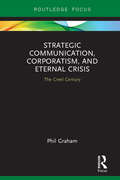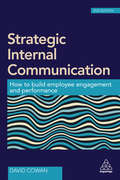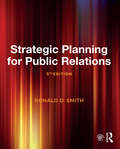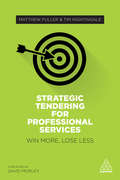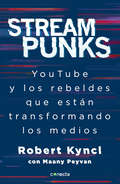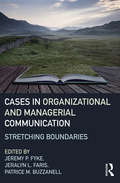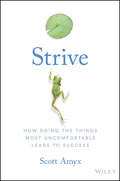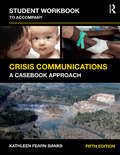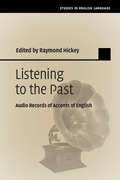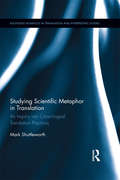- Table View
- List View
Sometimes You Have to Cross When It Says Don't Walk: A Memoir of Breaking Barriers
by Lesley VisserLesley Visser is living proof that, no matter where you start, if you are motivated and passionate, your dreams can come true. When Lesley was 11, she told her mother that she wanted to be a sportswriter. The job didn't exist for women in 1964, but her mother—instead of suggesting she become a teacher or a nurse—replied, "Great! Sometimes you have to cross when it says, 'Don't walk.'" That answer changed Lesley's life. Even though no one had done it before, it gave her the strength and self-confidence to try—permission to cross against the light. When Lesley began, the credentials said, "No Women or Children in the Press Box," but she didn't let that stop her. Lesley covered sports for more than 40 years, pioneering women's journalistic presence in men's professional sports, from inside the locker room to out on the field. She's the first and only woman to be enshrined in the Pro Football Hall of Fame and to ever present the Vince Lombardi Trophy at the Super Bowl. And she's the only sportscaster in history to have worked on the network broadcasts of the Final Four, Super Bowl, World Series, NBA Finals, Triple Crown, Olympics, U.S. Open, and the World Figure Skating Championship. Lesley currently appears on CBS's "We Need to Talk," the first-ever nationally televised all-female weekly hour-long sports show. Lesley's had her share of hurdles and stumbles. But with passion, perseverance, and dedication, she found a way to achieve her dream, learning valuable lessons along the way. (Hint: Humor goes further than anger, and no, we can't all look like Beyoncé.) In Sometimes You Have to Cross When It Says 'Don't Walk,' Lesley Visser shares her historic journey through the world of sports broadcasting with innate wisdom and good humor. For sports fans who grew up with Lesley, her memoir reads like a walk down memory lane, full of behind-the-camera, VIP-access stories involving John Madden, Jerry Jones, Bill Belichick, Joe Torre, and many more famous sports figures. But even those hearing her story for the first time, no matter what their background, will be inspired to chase their dreams, blaze new trails, and pursue the life they want.
Spark: The Insight to Growing Brands
by Paddy RangappaSpark addresses the important issue of growing bands in an increasingly competitive, crowded market place. Written by an expert in marketing, here is a book that demystifies the esoteric subject of brand-building. Spark achieves this by providing a practical framework. It handholds the reader through the various stages of brand-building—how to generate an insight to address a specific business challenge; how to construct a full business plan around it; and how to leverage such a plan for revenue growth. Rich in case-studies of successful global brands like Dove, McDonald’s and Vicks VapoRub, and replete with brainstorming tips and catchy acronyms for developing successful brand campaigns with ad agencies, Spark offers a lifeline to the professional committed to building and nurturing a powerful brand.
Speak Up: An Illustrated Guide to Public Speaking
by Peter Arkle Joseph S. Tuman Douglas M. FraleighWritten by professors with 40+ combined years’ experience teaching the course, Speak Up! connects with students through lively writing, compelling real-life examples, practical guidance, and hundreds of custom-drawn illustrations that bring public speaking concepts to life. Instructors appreciate the book's serious coverage of concepts and theories, fascinating examples, and unique and often humorous illustrations that help students understand and retain concepts from the text. The new edition features a brand new case study feature that guides students through all steps of the public speaking process. The Speech Choices boxes follow Mia and Jacob as they make choices that affect the final outcome of their speech—and show students what to do, and what not to do. They culminate in two brand-new, full-length speech videos on cutting edge topics. The feature expands further online in LaunchPad with video clips from the speeches, case study questions, and case study activities that instructors can use in the classroom or assign as homework. Speak Up contains other powerful digital tools accessible through LaunchPad, a learning platform that that contains hundreds of videos, LearningCurve (our adaptive quizzing program), various assessment options, video assignment tools, instructor supplements, and a full e-book.
Spectrum Sharing in Wireless Networks: Fairness, Efficiency, and Security
by John D. Matyjas, Sunil Kumar and Fei HuSpectrum Sharing in Wireless Networks: Fairness, Efficiency, and Security provides a broad overview of wireless network spectrum sharing in seven distinct sections: The first section examines the big picture and basic principles, explaining the concepts of spectrum sharing, hardware/software function requirements for efficient sharing, and future trends of sharing strategies. The second section contains more than 10 chapters that discuss differing approaches to efficient spectrum sharing. The authors introduce a new coexistence and sharing scheme for multi-hop networks, describe the space-time sharing concept, introduce LTE-U, and examine sharing in broadcast and unicast environments. They then talk about different cooperation strategies to achieve mutual benefits for primary users (PU) and secondary users (SU), discuss protocols in a spectrum sharing context, and provide different game theory models between PUs and SUs. The third section explains how to model the interactions of PUs and SUs, using an efficient calculation method to determine spectrum availability. Additionally, this section explains how to use scheduling models to achieve efficient SU traffic delivery. The subject of the fourth section is MIMO-oriented design. It focuses on how directional antennas and MIMO antennas greatly enhance wireless network performance. The authors include a few chapters on capacity/rate calculations as well as beamforming issues under MIMO antennas. Power control is covered in the fifth section which also describes the interference-aware power allocation schemes among cognitive radio users and the power control schemes in cognitive radios. The sixth section provides a comprehensive look at security issues, including different types of spectrum sharing attacks and threats as well as corresponding countermeasure schemes. The seventh and final section covers issues pertaining to military applications and examines how the military task protects its data flows when sharing the spectrum with civilian applications.
Speech and Debate as Civic Education (Rhetoric and Democratic Deliberation #15)
by J. Michael Hogan Jessica A. Kurr Michael J. Bergmaier Jeremy D. JohnsonIn an era increasingly marked by polarized and unproductive political debates, this volume makes the case for a renewed emphasis on teaching speech and debate, both in and outside of the classroom.Speech and debate education leads students to better understand their First Amendment rights and the power of speaking. It teaches them to work together collaboratively to solve problems, and it encourages critical thinking, reasoned and fact-based argumentation, and respect for differing viewpoints in our increasingly diverse and global society. Highlighting the need for more emphasis on the ethics and skills of democratic deliberation, the contributors to this volume—leading scholars, teachers, and coaches in speech and debate programs around the country—offer new ideas for reinvigorating curricular and co-curricular speech and debate by recovering and reinventing their historical mission as civic education.Combining historical case studies, theoretical reflections, and reports on programs that utilize rhetorical pedagogies to educate for citizenship, Speech and Debate as Civic Education is a first-of-its-kind collection of the best ideas for reinventing and revitalizing the civic mission of speech and debate for a new generation of students.In addition to the editors, the contributors to this volume include Jenn Anderson, Michael D. Bartanen, Ann Crigler, Sara A. Mehltretter Drury, David A. Frank, G. Thomas Goodnight, Ronald Walter Greene, Taylor W. Hahn, Darrin Hicks, Edward A. Hinck, Jin Huang, Una Kimokeo-Goes, Rebecca A. Kuehl, Lorand Laskai, Tim Lewis, Robert S. Littlefield, Allan D. Louden, Paul E. Mabrey III, Jamie McKown, Gordon R. Mitchell, Catherine H. Palczewski, Angela G. Ray, Robert C. Rowland, Minhee Son, Sarah Stone Watt, Melissa Maxcy Wade, David Weeks, Carly S. Woods, and David Zarefsky.
Speech Coding
by Tom BäckströmThis book provides scientific understanding of the most central techniques used in speech coding both for advanced students as well as professionals with a background in speech audio and or digital signal processing. It provides a clear connection between the Why’s?, How’s?, and What’s, such that the necessity, purpose and solutions provided by tools should be always within sight, as well as their strengths and weaknesses in each respect. Equivalently, this book sheds light on the following perspectives for each technology presented: Objective: What do we want to achieve and especially why is this goal important? Resource / Information: What information is available and how can it be useful? Resource / Platform: What kind of platforms are we working with and what are the capabilities/restrictions of those platforms? This includes properties such as computational, memory, acoustic and transmission capacity of devices used. Solutions: Which solutions have been proposed and how can they be used to reach the stated goals? Strengths and weaknesses: In which ways do the solutions fulfill the objectives and where are they insufficient? Are resources used efficiently? This book concentrates solely on code excited linear prediction and its derivatives since mainstream speech codecs are based on linear prediction It also concentrates exclusively on time domain techniques because frequency domain tools are to a large extent common with audio codecs.
Spellbound: Seven Principles of Illusion to Captivate Audiences and Unlock the Secrets of Success
by David KwongA professional magician and illusionist—the head magic consultant for the hit film Now You See Me—reveals how to bridge the gap between perception and reality to increase your powers of persuasion and influence.David Kwong has astounded corporate CEOs, TED talk audiences, and thousands of other hyper-rational people, making them see, believe, and even remember what he wants them to. Illusion is an ancient art that centers on control: commanding a room, building anticipation, and appearing to work wonders. Illusion works because the human brain is wired to fill the gap between seeing and believing. Successful leaders—like Steve Jobs, Warren Buffett, and Ted Turner—are masters of control and command who understand how to sway opinions and achieve goals.In his years of research and practice, David has discovered seven fundamental principles of illusion. With these rules anyone can learn to:Mind the Gap—recognize and employ the perceptual space between your audience’s ability to see and their impulse to believe.Load Up—prepare to amaze your audience.Write the Script—discover the importance of shaping the narrative that surrounds your illusion.Control the Frame—explore the real life value of a magician’s best friend: misdirection.Design Free Choice—command your audience by giving them agency.Employ the Familiar—take secret advantage of habits, patterns, and audience expectations.Conjure an Out—develop backup plans that will keep you one, two, three, or more steps ahead of the competition.With Spellbound you’ll discover a different way to sell your idea, product, or skills, and make your best shot better than everyone else’s.
Spinning History: Politics and Propaganda in World War II
by Nathaniel LandeAn “original and insightful” look at World War II through the lens of theater, propaganda, and the most important performances in human history (Richard Cole, PhD). In this fascinating book, more relevant than ever in today’s political climate of “fake news” and “alternative facts,” bestselling author and historian Nathaniel Lande presents WWII as a drama staged and overseen by four contrasting masters: Roosevelt, Churchill, Hitler, and Stalin. Each man had his own script for elaborately produced campaigns of deception, winning hearts and minds on the frontlines and the home front. Each leader used all the tools at his disposal to promote his own narrative of the Second World War. Brilliantly conceived oratory was applied to underscore each vision. Impression management—the art of political spin—was employed to drive the message home. Each side employed uniforms, meticulously staged events, and broadcast their messages via all media available—motion pictures, radio broadcasts, songs, posters, leaflets, and beyond. The result of Lande’s exploration is “an illuminating, readable, and still very relevant account of the ways in which theatrical staging, dramatic storytelling, and message manipulation were key to the efforts of both sides during those turbulent years” (Richard Zoglin, senior editor, Time).
Standing Up, Speaking Out: Stand-Up Comedy and the Rhetoric of Social Change
by Matthew R. Meier Casey R. SchmittIn recent decades, some of the most celebrated and culturally influential American oratorical performances have come not from political leaders or religious visionaries, but from stand-up comics. Even though comedy and satire have been addressed by rhetorical scholarship in recent decades, little attention has been paid to stand-up. This collection is an attempt to further cultivate the growing conversation about stand-up comedy from the perspective of the rhetorical tradition. It brings together literatures from rhetorical, cultural, and humor studies to provide a unique exploration of stand-up comedy that both argues on behalf of the form’s capacity for social change and attempts to draw attention to a series of otherwise unrecognized rhetors who have made significant contributions to public culture through comedy.
Stories for Work: The Essential Guide to Business Storytelling
by Gabrielle DolanLearn the science and master the art of telling a great story Stories for Work walks you through the science of storytelling, revealing the secrets behind great storytellers and showing you how to master the art of storytelling in business. Stories hold a unique place in our psyche, and the right story at the right time can be a game-changer in business; whether tragedy, triumph, tension or transition, a good story can captivate the listener and help you achieve your goals. In this book, author Gabrielle Dolan draws from a decade of training business leaders in storytelling to show you what works, why it works, when it works best and what never works. You'll learn how to create your own stories — authentically yours, crafted to attain your goal — and develop an instinct for sharing when the time is right. In-depth case studies feature real-world people in real-world businesses, showing how storytelling has changed the way they work, motivate and lead — providing clear examples of the power of this enormously effective skill. Storytelling gives you an edge. Whether you're after a promotion, a difficult client, a big sale or leading through transition, a great story can help you smooth the road and seal the deal. This book is your personal coach for masterful storytelling, with expert guidance and lessons learned from real-world business leaders. Learn why storytelling grabs attention and helps your message get through Master the four types of stories used in business settings Infuse your stories with the personal to highlight your vision and values Craft a selection of stories to pull out at pivotal business moments The oral tradition has ancient roots that unite all humans, and despite our myriad modern distractions, we still respond to a well-told story. Stories for Work helps you put this dynamic to work for you in any business scenario.
Stories Make the World: Reflections on Storytelling and the Art of the Documentary
by Stephen MostSince the beginning of human history, stories have helped people make sense of their lives and their world. Today, an understanding of storytelling is invaluable as we seek to orient ourselves within a flood of raw information and an unprecedented variety of supposedly true accounts. In Stories Make the World, award-winning screenwriter Stephen Most offers a captivating, refreshingly heartfelt exploration of how documentary filmmakers and other storytellers come to understand their subjects and cast light on the world through their art. Drawing on the author's decades of experience behind the scenes of television and film documentaries, this is an indispensable account of the principles and paradoxes that attend the quest to represent reality truthfully.
Storyshowing: How to Stand Out from the Storytellers
by Sam CawthornTake your audience on a journey to leave a more lasting impact Storyshowing is an instruction manual for making connections. Storytelling has been shown to be one of the most effective methods of persuasion, motivation and inspiration, yet the disconnect remains — you're still only telling. To truly influence people, you need to go deeper than that — you need to show them your story. By inviting your audience in, you connect on a much deeper, more emotional level; you bypass the brain and connect at the root of what it means to be human, leaving a profound impact on their entire outlook. This book shows you how to transcend telling and start showing your story, using an easy-to-follow framework you can start applying today. Unearth your own experiences, and bring your vulnerabilities out into the light; share your emotions and forge a path to true communication. Use images, body language and gestures as tools to build that indelible connection; then and only then will people truly engage and transform their thinking. No matter your message, the impact lies in the delivery. This insightful guide equips you with the tools and skills you need to start communicating like never before. Share more powerful stories using a simple 5-step method Build confidence, influence others and make a deeper connection Be more persuasive in presentations, pitches, calls and talks Transform the way people think by inviting them inside your story The difference between telling and showing is like the difference between a lecture and a play. It's the difference between giving information and taking the audience on a journey. The difference between a brochure and a test drive. Storyshowing helps you level up your communication to leave a lasting, more profound impact.
Straight Talk About Communication Research Methods
by Christine S Davis Kenneth A LachlanResearchers are like detectives. Both are trying to find something out. Both are asking and answering questions. Both are trying to put together a puzzle to come up with a solution. In both, answering questions leads to more questions. And, in both, seeing patterns is crucial to solving the puzzle. Straight Talk about Communication Research Methods presents the foundations of research methods, the choices scholars make, and the methodological decisions driving communication scholarship to balance one’s desire to know and inquire into interesting communication questions while instilling an enthusiasm about the process! Featuring a student friendly writing style, Straight Talk about Communication Research Methods is built on adult learning theory – information is given in small chunks that build upon each other, repeating then expanding knowledge. Featuring updated information and examples, the new third edition of Straight Talk about Communication Research Methods: Is Modern! The text includes material on conducting research on, and involving, social and digital media. Is Practical! Examples of how students might use communication research methods in business and industry jobs after graduation are integrated throughout. Is Groundbreaking! The text features four chapters that summarize new qualitative research methods along with comprehensive instructions on how to conduct these research methods. Is Interactive! A seamlessly integrated enhanced learning package provides both students and instructors access to online content, interactive exercises and more.
Strategic Communication: New Agendas in Communication (New Agendas in Communication Series)
by Anthony Dudo LeeAnn KahlorThe focus of this book is Strategic Communication. Communication can be defined as strategic if its development and/or dissemination is driven by an expected outcome. These outcomes can be attitudinal, behavioral, persuasive or knowledge-related; they can lead to change or engagement, or they can miss their mark entirely. In looking at strategic communication, one is not limited to a specific context or discipline. Many of the scholars in the volume are generating research that covers strategic communication in ways that are meaningful across fields. This volume collects the work and idea of scholars who cover the spectrum of strategic communication from source to message to audience to channel to effects. Strategic Communication offers news perspectives across contexts and is rooted firmly in the rich research traditions of persuasion and media effects. Spanning multiple disciplines and written to appeal to a large audience, this book will be found in the hands of researchers, graduate students, and students doing interdisciplinary coursework.
Strategic Communication, Corporatism, and Eternal Crisis: The Creel Century
by Phil GrahamThis book traces a century of militarised communication that began in the United States in April, 1917, with the institution of the Committee on Public Information (CPI), headed by George Creel and tasked with persuading a divided US public to enter World War I. Creel achieved an historic feat of communication: a nationalising mass mediation event well before any instantaneous mass media technologies were available. The CPI’s techniques and strategies have underpinned marketing, public relations, and public diplomacy practices ever since. The book argues that the CPI’s influence extends unbroken into the present day, as it provided the communicative and attitudinal bases for a new form of political economy, a form of corporatism, that would come to its fullest flower in the “globalisation” project of the mid-1990s.
Strategic Internal Communication: How to Build Employee Engagement and Performance
by Dr David CowanPreviously restricted to cascading information and managing day-to-day conversations, internal communication is now essential to empowering employees to deliver business strategy. Strategic Internal Communication shows how to design and implement a strategy which will lead to engaged and motivated staff, increased productivity and consequently improved business performance. The book uses the author's own Dialogue Box tool designed to help companies explore more thoroughly what kinds of conversations they need to have with employees to address internal and cultural challenges. It helps transform organizations into open and transparent communities to ensure that entire workforces are committed to the overall business vision.This fully updated 2nd edition of Strategic Internal Communication includes new information on how to use Dialogue Box during times of transition and organizational change. It also gives advice on how to manage difficult conversations and avoid damaging miscommunication and misinterpretation. Supported by examples and case studies from the author's own experience, Strategic Internal Communication is an indispensable guide to creating an integrated and collaborative culture which will take your organization to the next level of success.
Strategic Planning for Public Relations
by Ronald D. SmithStrategic Planning for Public Relations is in its fifth edition of offering an innovative and clear approach for students looking to learn how to develop public relations campaigns. It is a text intended for those serious about entering the rapidly changing professions of public relations and strategic communication. Ronald Smith shows how to implement pragmatic, research-driven strategic campaigns used in public relations practice, and draws from his years of experience as a professional in the industry and his years of teaching in the classroom. The approach used in this text is a threefold pattern: first, readers are exposed to new ideas, then see them in use, before finally being showed how to apply those ideas themselves. Complex problem-solving and decision-making processes in strategic communication and public relations are turned into a series of easy-to-follow steps, flexible enough to be applicable to myriad situations and organizations in the real world. This new fifth edition follows the same format as previous editions and includes numerous timely and real-world examples of cases and current events, along with classic cases that stand the test of time. It includes new research on opinions and practices within the discipline and covers several recent, award-winning public relations campaigns.
Strategic Tendering for Professional Services: Win More, Lose Less
by Matthew Fuller Tim NightingaleCompetitive bidding for work is a long-established aspect of business within the professional services and consulting sector. For many markets, pitching has become a critical element of both attracting and retaining business. Combating clients' demands and intense competition, firms that want to win and retain business need business development and marketing teams that are experts in creating compelling proposals. Strategic Tendering for Professional Services offers a masterclass in improving your pitching skills and processes.Drawing on insights from current pitch and proposal professionals and client-side procurement teams, Strategic Tendering for Professional Services provides end-to-end best practice guidance. From the crucial decision of which request-for-proposals (RFPs) to respond to, right through to the all-important face-to-face presentation and post-pitch follow-up, this practical handbook leads readers through all stages of the process on best practice and strategies for success. Packed with practical features to help readers put guidance into practice, Strategic Tendering for Professional Services also supports business-wide improvement with a clear analysis of the processes and systems available to support pitch assembly and reporting. Whether you are a bid and proposal professional looking for extra tools, a business development or marketing manager providing support and expertise to partners, or a professional wanting to improve pitching skills, this book will be key to winning opportunities that will set the firm apart.
Streampunks: Youtube y los rebeldes que estan transformando los medios
by Robert Kyncl<P>En los últimos diez años, la plataforma de videos por internet YouTube ha cambiado los medios y el entretenimiento tan profundamente como lo hicieron la invención del cine, la radio y la televisión. <P>Streampunks es una mirada a esta empresa advenediza que examina cómo ha evolucionado YouTube y hacia dónde va. <P>Basándose en relatos de las estrellas más influyentes de YouTube (Streampunks como Tyler Oakley, Lilly Singh y Casey Neistat) y los negociadores que promueven el futuro del entretenimiento (como Scooter Braun y Shane Smith), Robert Kyncl utiliza sus experiencias en tres de las compañías de medios más innovadoras, HBO, Netflix y Youtube, para contar la historia del streaming y de este monstruo moderno de la cultura pop. <P>En colaboración con Maany Peyvan (escritor de contenido de Google), Kyncl explica cómo se dictan las nuevas reglas del entretenimiento y cómo y por qué el panorama de los medios está cambiando radicalmente.
Stretching Boundaries: Stretching Boundaries
by Patrice M. Buzzanell Jeremy Fyke Jeralyn FarisStretching Boundaries: Cases in Organizational and Managerial Communication focuses on non-traditional organizations in a variety of contexts. Because cases range from small family-owned entrepreneurships and cybervetting to provincial egovernment democratic movements in China, this supplemental text enables a reexamination of the boundaries of traditional organizational contexts. Cases delve into organizing structures, relationships, and visions for global not-for-profits, hybrid, creative industry, and entrepreneurial organizations. This book stands to benefit instructors and students in at least four ways. First, it provides instructors with an application-based teaching tool to help spark discussion. Second, students will find the case studies interesting and applicable to their future work lives, especially undergraduates who will soon be in the work force. Additionally, cases help students grasp course materials that may be otherwise challenging. Finally, for graduate students, the book encourages reflection on important topics for future research.
Strive: How Doing The Things Most Uncomfortable Leads to Success
by Scott AmyxHas success eluded you, no matter how hard you try? Are you frustrated by trying to achieve your dreams by copying others? Internationally-acclaimed speaker and founder of the cutting-edge venture capital Amyx Ventures, Scott Amyx reveals how you can attain real success in your life, your way. His theory of Strive is a challenge to the conventional wisdom that has held so many people back from achieving their goals and enjoying lasting happiness. Scott rose from obscure poverty to globe-trotting success, and he invites you to share in his journey by adopting a new mindset towards your personal challenges: embrace them. Scott shows you how through stories of the most unlikely individuals who embraced difficult personal change to become outrageously successful. He helps you take stock of your own habits and practices to identify how your routine and misconceptions are holding you back. Fascinating insights from throughout history up through today’s cutting-edge research show how embracing discomfort fuels lasting success. Shape your life in new, exciting ways. You can have control over your career, your outlook, your actions, and your priorities. This book helps you get a fresh start to begin building the successful life you want. Discover what really drives success---and how conventional wisdom is wrong Clearly identify your own personal challenges---and how to overcome them Delve into the latest research on high performance to create a better you Learn how high-achievers approach challenge, change, and success Strive is an unconventional approach to attaining your dreams because it takes what makes you unique and turns it to your advantage. Have you been duped by common myths of success? Are you disappointed by the constant struggle in life? Scott reveals how only you have the power to change your trajectory. Strive is your handbook for getting comfortable with discomfort, embracing and enjoying new challenges, and achieving real, lasting success.
Student Workbook to Accompany Crisis Communications: A Casebook Approach
by Kathleen Fearn_Banks Kathleen Fearn-BanksNo company, organization, or individual whose livelihood depends on public reaction can afford to function without a crisis communications plan. This student workbook reviews the critical terminologies, processes, and skills needed for understanding and responding to crises. It prepares individuals for responding to crises in a variety of contexts, and reinforces strategies and tactics to be used during a crisis. Chapters include instructive case studies of public relations professionals in crises: what they did, what they wished they had done, and what hampered their progress. The exercises provide students with the opportunity to respond to real-world crises, sharpening their own skills and practicing response behaviors. This workbook will serve as a useful tool for all future practitioners.
Studies in English Language: Listening to the Past
by Raymond HickeyAudio recordings of English are available from the first half of the twentieth century and thus complement the written data sources for the recent history of the language. This book is the first to bring together a team of globally recognised scholars to document and analyse these early recordings in a single volume. Looking at examples of regional varieties of English from England, Scotland, Ireland, the USA, Canada and other anglophone countries, the volume explores both standard and vernacular varieties, and demonstrates how accents of English have changed between the late nineteenth century and the present day. The socio-phonetic examinations of the recordings will be of interest to scholars of historical linguistics, the history of the English language, language variation and change, phonetics, and phonology.
Studying Scientific Metaphor in Translation (Routledge Advances in Translation and Interpreting Studies)
by Mark ShuttleworthStudying Scientific Metaphor in Translation presents a multilingual examination of the translation of metaphors. Mark Shuttleworth explores this facet of translation and develops a theoretically nuanced description of the procedures that translators have recourse to when translating metaphorical language. Drawing on a core corpus consisting of six Scientific American articles in the fields of neurobiology and biotechnology dating from 2004, along with their translations into Chinese, French, German, Italian, Polish and Russian, Shuttleworth provides a data-driven and theoretically informed picture of the processes that underpin metaphor translation. The book builds interdisciplinary bridges between translation scholars and metaphor researchers, proposes a new set of procedures for metaphor translation conceived within the context of descriptive translation studies, and puts forward a possible resolution to the debate on metaphor translatability.
Succeeding with Senior Management: Getting the Right Support at the Right Time for Your Project
by G. Michael CampbellSenior managers speak the language of strategy. Project managers use the language of tasks and activities. While they rely on each other to achieve their goals, this core incompatibly can lead to communication breakdowns and project setbacks.Succeeding with Senior Management explains how to bridge the gap and engage the upper ranks. By establishing relationships early on, understanding executives, and keeping them involved, project managers win the support they need—especially critical when problems arise. This one-of-a-kind communications guide explains how to:Navigate the company?s political watersLink the project to the businessDevelop a case for change with an executive sponsorUse the right listening styleProvide options and recommendations for major decisionsInvolve the sponsor in resolving cross-functional problemsAnd moreMany executives will set a project in motion and then move on. Learn how to keep them involved, motivated to push obstacles aside, and focused on a successful conclusion. Your career prospects depend on it.
